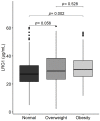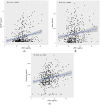Increased LRG1 Levels in Overweight and Obese Adolescents and Its Association with Obesity Markers, Including Leptin, Chemerin, and High Sensitivity C-Reactive Protein
- PMID: 35955698
- PMCID: PMC9369195
- DOI: 10.3390/ijms23158564
Increased LRG1 Levels in Overweight and Obese Adolescents and Its Association with Obesity Markers, Including Leptin, Chemerin, and High Sensitivity C-Reactive Protein
Abstract
Leucine-rich α-2 glycoprotein1 (LRG1) is a member of the leucine-rich repeat (LRR) family that is implicated in multiple diseases, including cancer, aging, and heart failure, as well as diabetes and obesity. LRG1 plays a key role in diet-induced hepatosteatosis and insulin resistance by mediating the crosstalk between adipocytes and hepatocytes. LRG1 also promotes hepatosteatosis by upregulating de novo lipogenesis in the liver and suppressing fatty acid β-oxidation. In this study, we investigated the association of LRG1 with obesity markers, including leptin and other adipokines in adolescents (11−14 years; n = 425). BMI-for-age classification based on WHO growth charts was used to define obesity. Plasma LRG1 was measured by ELISA, while other markers were measured by multiplexing assay. Median (IQR) of LRG1 levels was higher in obese (30 (25, 38) µg/mL) and overweight (30 (24, 39) µg/mL) adolescents, compared to normal-weight participants (27 (22, 35) µg/mL). The highest tertile of LRG1 had an OR [95% CI] of 2.55 [1.44, 4.53] for obesity. LRG1 was positively correlated to plasma levels of high sensitivity c-reactive protein (HsCRP) (ρ = 0.2), leptin (ρ = 0.2), and chemerin (ρ = 0.24) with p < 0.001. Additionally, it was positively associated with plasma level of IL6 (ρ = 0.17) and IL10 (ρ = 0.14) but not TNF-α. In conclusion, LRG1 levels are increased in obese adolescents and are associated with increased levels of adipogenic markers. These results suggest the usefulness of LRG1 as an early biomarker for obesity and its related pathologies in adolescents.
Keywords: Interleukin 6; TNF-α; adolescents; high sensitivity C-reactive protein; leucine-rich α-2 glycoprotein 1; obesity.
Conflict of interest statement
The authors declare no conflict of interest. The funders had no role in the design of the study; in the collection, analyses, or interpretation of data; in the writing of the manuscript; or in the decision to publish the results.
Figures
Similar articles
-
Leucine-Rich Alpha-2-Glycoprotein as a non-invasive biomarker for pediatric acute appendicitis: a systematic review and meta-analysis.Eur J Pediatr. 2023 Jul;182(7):3033-3044. doi: 10.1007/s00431-023-04978-2. Epub 2023 May 6. Eur J Pediatr. 2023. PMID: 37148275 Free PMC article.
-
LRG1 is an adipokine that mediates obesity-induced hepatosteatosis and insulin resistance.J Clin Invest. 2021 Dec 15;131(24):e148545. doi: 10.1172/JCI148545. J Clin Invest. 2021. PMID: 34730111 Free PMC article.
-
Adolescent obesity and ANGPTL8: correlations with high sensitivity C-reactive protein, leptin, and chemerin.Front Endocrinol (Lausanne). 2023 Dec 22;14:1314211. doi: 10.3389/fendo.2023.1314211. eCollection 2023. Front Endocrinol (Lausanne). 2023. PMID: 38189043 Free PMC article.
-
Association of circulating proinflammatory marker, leucine-rich-α2-glycoprotein (LRG1), following metabolic/bariatric surgery.Diabetes Metab Res Rev. 2018 Oct;34(7):e3029. doi: 10.1002/dmrr.3029. Epub 2018 Jul 23. Diabetes Metab Res Rev. 2018. PMID: 29883055
-
Revealing the multiple faces of LRG1: gene expression, structure, function, and therapeutic potential.J Adv Res. 2025 May 12:S2090-1232(25)00342-X. doi: 10.1016/j.jare.2025.05.024. Online ahead of print. J Adv Res. 2025. PMID: 40368176 Review.
Cited by
-
Leucine-Rich Alpha-2-Glycoprotein as a non-invasive biomarker for pediatric acute appendicitis: a systematic review and meta-analysis.Eur J Pediatr. 2023 Jul;182(7):3033-3044. doi: 10.1007/s00431-023-04978-2. Epub 2023 May 6. Eur J Pediatr. 2023. PMID: 37148275 Free PMC article.
-
Proteomic Signatures of the Serological Response to Influenza Vaccination in a Large Human Cohort Study.Viruses. 2022 Nov 9;14(11):2479. doi: 10.3390/v14112479. Viruses. 2022. PMID: 36366577 Free PMC article.
-
Diet-enhanced LRG1 expression promotes insulin hypersecretion and ER stress in pancreatic beta cells.Diabetologia. 2025 Mar;68(3):615-628. doi: 10.1007/s00125-024-06331-0. Epub 2024 Nov 26. Diabetologia. 2025. PMID: 39589509 Free PMC article.
-
Generational Diet-Induced Obesity Remodels the Omental Adipose Proteome in Female Mice.Nutrients. 2024 Sep 13;16(18):3086. doi: 10.3390/nu16183086. Nutrients. 2024. PMID: 39339686 Free PMC article.
-
LRG1 Associates with Iron Deficiency Anemia Markers in Adolescents.Nutrients. 2023 Jul 11;15(14):3100. doi: 10.3390/nu15143100. Nutrients. 2023. PMID: 37513518 Free PMC article.
References
-
- Sinaiko A.R., Jacobs D.R., Steinberger J., Moran A., Luepker R., Rocchini A.P., Prineas R.J. Insulin resistance syndrome in childhood: Associations of the euglycemic insulin clamp and fasting insulin with fatness and other risk factors. J. Pediatr. 2001;139:700–707. doi: 10.1067/mpd.2001.118535. - DOI - PubMed
MeSH terms
Substances
Grants and funding
LinkOut - more resources
Full Text Sources
Research Materials
Miscellaneous




